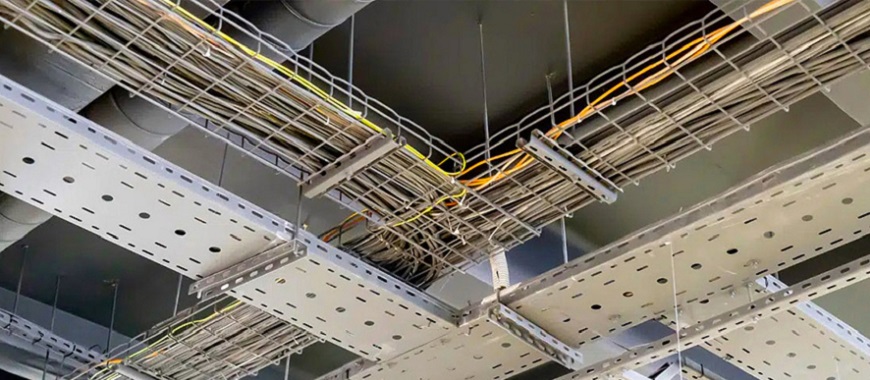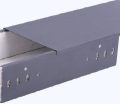
A device cable tray is a crucial component in modern cable management, designed to streamline organization and provide robust protection for cables in various installations. It serves as a structured pathway, preventing cable tangling, reducing physical damage, and ensuring safe, efficient routing. In industrial setups, a device cable tray supports heavy-duty power cables, while in commercial environments, it manages communication and low-voltage wiring. Residential installations benefit from its ability to organize cables neatly, improving safety and aesthetics. By offering flexibility in design and durability, a device cable tray is an essential solution for maintaining the integrity of cable systems in diverse applications, ensuring long-term reliability and ease of maintenance.
How About Optimizing a Device Cable Tray for Efficient Installations?
A device cable tray serves as a critical solution for organizing, supporting, and protecting cables connected to various devices across industrial, commercial, and residential environments. Proper installation and optimization ensure functionality, safety, and scalability for future needs. Below, we delve into the benefits, factors, and applications of a device cable tray.
Benefits of Using a Device Cable Tray
Implementing a device cable tray provides numerous advantages, ensuring efficiency and reliability in cable management systems. Key benefits include:
- Organized Cable Management:
A device cable tray streamlines cable pathways, reducing tangling and maintaining an orderly layout for device connections. - Enhanced Safety:
By organizing and securing cables, device cable trays reduce risks such as tripping hazards, short circuits, and overheating. - Maintenance Accessibility:
Open designs enable easy identification and access to cables, simplifying repairs and upgrades without disrupting connected devices. - Device Protection:
These trays prevent cables from being exposed to mechanical damage or environmental hazards, extending their lifespan. - Future Scalability:
With adequate planning, device cable trays can accommodate additional cables for future devices, minimizing the need for new infrastructure.
Factors Influencing the Selection of a Device Cable Tray
Selecting the right device cable tray requires careful evaluation of various factors to meet specific project requirements. Important considerations include:
- Material Strength and Durability:
GangLong Fiberglass offers FRP device cable trays that resist corrosion, UV damage, and wear, ideal for demanding environments. - Load Capacity:
The tray must support the weight of the cables and connected devices without compromising its structural integrity. - Environmental Conditions:
Indoor installations prioritize aesthetics and cable accessibility, while outdoor setups require materials resistant to weather and moisture. - Space Availability:
The size and layout of the installation area influence the dimensions and type of tray to be selected. - Compliance Standards:
Ensuring that the device cable tray adheres to local and international safety standards is crucial for legal and operational assurance.
Applications of Device Cable Trays
Device cable trays are versatile and cater to various industries and environments, supporting critical connections between devices. Common applications include:
- Industrial Automation:
Device cable trays manage and protect the wiring for sensors, controllers, and robotic systems in manufacturing plants. - Telecommunications Hubs:
They support structured cabling for network devices, ensuring reliable connectivity in data centers and communication facilities. - Commercial Buildings:
Office complexes use device cable trays to organize power and network cables for workstations and servers. - Healthcare Facilities:
Medical devices and diagnostic equipment rely on device cable trays for safe and efficient cable management. - Educational Institutions:
Laboratories and classrooms benefit from device cable trays for organizing cabling in digital learning setups.
Best Practices for Installing a Device Cable Tray
Proper installation of a device cable tray maximizes its performance and ensures long-term reliability. Recommended practices include:
- Accurate Load Assessment:
Calculate the weight of all cables and ensure the tray can handle the load with a margin for future expansions. - Strategic Placement:
Install the tray in a position that minimizes cable length while maintaining accessibility for maintenance. - Securing Cables Firmly:
Use ties and clamps to keep cables in place within the tray, preventing movement or disconnections. - Maintaining Adequate Spacing:
Ensure sufficient space between cables to allow for heat dissipation and minimize interference. - Conducting Regular Inspections:
Periodic checks of the tray and cables help identify potential wear or damage, ensuring continued system performance.
Challenges in Device Cable Tray Management
Designing and maintaining a device cable tray system presents certain challenges that require thoughtful solutions. These include:
- Space Constraints:
Limited space in installation areas can complicate tray placement and require custom designs. - Cable Variety:
Managing cables of different types, sizes, and purposes within the same tray can affect capacity and layout planning. - Environmental Risks:
Harsh conditions such as exposure to chemicals, extreme temperatures, or moisture necessitate durable and protective materials. - Device Compatibility:
Ensuring the tray accommodates all connected devices without overcrowding or exceeding load capacity can be complex. - Future Expansion Needs:
Planning for additional devices while maintaining the integrity of the existing system requires foresight and scalability.
Innovations in Device Cable Tray Technology
Advancements in materials and design have revolutionized the functionality and flexibility of device cable trays. Key innovations include:
- Smart Monitoring Systems:
Integrated sensors in trays detect cable faults, monitor load conditions, and provide real-time feedback for maintenance. - Modular Designs:
Modular device cable trays allow for easy reconfiguration and expansion as systems evolve. - Lightweight Materials:
FRP materials from GangLong Fiberglass provide a combination of strength and reduced weight, simplifying installation and transport. - Improved Ventilation Features:
Enhanced designs facilitate airflow, reducing the risk of overheating and maintaining device performance. - Custom Fabrication:
Tailored trays meet specific project requirements, ensuring compatibility with unique device and cable configurations.
How GangLong Fiberglass Supports Device Cable Tray Solutions
At GangLong Fiberglass, we specialize in providing high-quality device cable trays designed to meet diverse project needs. Our offerings include:
- Durable FRP Trays:
Our trays are resistant to corrosion, fire, and UV exposure, making them suitable for challenging environments. - Custom Solutions:
We collaborate with clients to develop device cable trays tailored to their specific requirements. - Technical Support:
Our team provides guidance throughout the design, installation, and maintenance processes to ensure optimal outcomes. - Eco-Friendly Manufacturing:
We prioritize sustainable practices, delivering reliable products with minimal environmental impact. - Comprehensive Product Range:
From ladder trays to solid-bottom designs, we offer a variety of options to accommodate different applications.
Tips for Maintaining a Device Cable Tray
Routine maintenance is essential for extending the lifespan and efficiency of a device cable tray system. Effective maintenance practices include:
- Inspecting for Wear and Damage:
Regularly check the tray and cables for signs of corrosion, physical damage, or wear and take corrective actions as needed. - Clearing Debris Accumulations:
Remove dust, dirt, or debris that could obstruct airflow or damage cables within the tray. - Reinforcing Connections:
Tighten loose brackets, clamps, or fasteners to prevent tray misalignment or instability. - Updating Trays and Cables:
Plan for upgrades or replacements when adding new devices or when existing components show signs of aging. - Monitoring Device Performance:
Ensure that cables within the tray remain in good condition to support uninterrupted device operation.
A device cable tray system is integral to maintaining organized, efficient, and safe connections between devices. At GangLong Fiberglass, we are dedicated to delivering innovative and reliable solutions tailored to meet the diverse needs of our clients.
What Are the Key Features of a Device Cable Tray?
A device cable tray is essential for organizing, securing, and protecting the cables that connect devices across a wide range of environments. Proper implementation ensures reliability, safety, and long-term efficiency. Below, we discuss the core aspects of device cable trays, from benefits to best practices and applications.
Benefits of Using a Device Cable Tray
A device cable tray provides numerous advantages, making it a vital component in cable management systems. These benefits include:
- Simplified Cable Organization:
A device cable tray ensures that cables are arranged in an orderly manner, reducing clutter and improving accessibility. - Enhanced Safety Measures:
By keeping cables properly supported, the tray minimizes risks such as tripping hazards, overheating, and accidental disconnections. - Improved Maintenance Access:
Technicians can quickly locate and access cables within the tray for inspections, repairs, or upgrades, reducing downtime. - Protection Against Environmental Damage:
Device cable trays shield cables from potential mechanical damage, UV exposure, and moisture, increasing their lifespan. - Scalability for Future Needs:
Properly designed device cable trays allow for easy expansion, accommodating additional cables and devices as systems grow.
Factors to Consider When Selecting a Device Cable Tray
Choosing the right device cable tray involves evaluating several factors to ensure it meets project requirements and environmental conditions.
- Material Selection:
At GangLong Fiberglass, we offer FRP trays that provide exceptional durability, corrosion resistance, and lightweight properties, suitable for diverse applications. - Load Capacity:
The tray must support the total weight of the cables and devices it serves without compromising its structural integrity. - Environmental Conditions:
Outdoor installations require trays that are resistant to weather, UV rays, and temperature fluctuations, while indoor setups focus on accessibility and aesthetics. - Tray Dimensions:
The width, depth, and length of the tray should align with the space available and the number of cables to be supported. - Compliance with Safety Standards:
Ensuring the tray meets relevant safety and performance standards is critical for maintaining operational reliability.
Best Practices for Installing a Device Cable Tray
A well-installed device cable tray ensures optimal performance, safety, and ease of maintenance. Key practices include:
- Accurate Load Assessment:
Calculate the weight of all cables to be supported and verify that the tray’s load capacity exceeds this requirement with room for expansion. - Strategic Placement:
Position the tray to minimize cable lengths while maintaining accessibility for future modifications or maintenance. - Secure Cable Fastening:
Use ties, clamps, or brackets to keep cables in place and prevent movement that could lead to damage or disconnections. - Adequate Spacing Between Cables:
Allow enough space for airflow to reduce the risk of overheating and ensure efficient operation of connected devices. - Regular Inspection and Maintenance:
Periodic checks help identify signs of wear, corrosion, or other issues, allowing for timely intervention and system preservation.
Enhance Wire Basket Tray Stability with Cable Tray Liner
Applications of Device Cable Trays
Device cable trays are used in various industries and settings, providing reliable cable management for critical systems. Common applications include:
- Telecommunications:
Device cable trays are essential for managing structured cabling in communication hubs and data centers. - Industrial Automation:
Manufacturing facilities rely on these trays to organize cables for sensors, controllers, and other automated systems. - Commercial Buildings:
Offices use device cable trays to manage power, network, and peripheral cables efficiently. - Healthcare Environments:
Medical facilities use these trays to ensure the safe operation of diagnostic and monitoring equipment. - Educational Institutions:
Laboratories and classrooms benefit from device cable trays to organize cabling for technology and learning tools.
Challenges in Device Cable Tray Management
Managing device cable trays effectively can involve overcoming several challenges. Addressing these issues ensures optimal performance and safety.
- Cable Diversity:
Managing cables of various sizes, types, and purposes within a single tray requires careful planning and organization. - Environmental Hazards:
In harsh conditions, such as chemical exposure or extreme temperatures, selecting the right materials and protective features is essential. - Space Limitations:
Limited installation areas may necessitate custom tray designs to optimize space utilization without compromising functionality. - Load Capacity Constraints:
Ensuring the tray supports the total weight of cables and devices while allowing room for growth requires precise calculations. - Future Expansion Needs:
Balancing current system requirements with potential future expansions can be challenging without careful foresight.
Innovations in Device Cable Tray Technology
Recent advancements in technology have enhanced the functionality and flexibility of device cable trays. These innovations include:
- Smart Monitoring Systems:
Sensors integrated into device cable trays monitor conditions such as temperature and load, providing real-time feedback for maintenance. - Modular Tray Designs:
Modular systems allow for quick adjustments and expansions, making it easy to adapt to changing project requirements. - Advanced Materials:
GangLong Fiberglass offers lightweight, corrosion-resistant FRP trays that perform well in demanding environments. - Improved Ventilation Features:
Enhanced tray designs promote airflow around cables, reducing the risk of overheating and extending the lifespan of connected devices. - Custom Fabrication Options:
Tailored device cable trays meet specific requirements, ensuring compatibility with unique system configurations.
The Fiberglass Rod Inside Many Fiber-Optic Cables Is For What
How GangLong Fiberglass Supports Device Cable Tray Solutions
GangLong Fiberglass specializes in providing high-quality device cable trays designed for a wide range of applications. Our offerings include:
- Durable FRP Materials:
Our device cable trays are made from fiberglass-reinforced plastic, combining strength, lightweight properties, and resistance to corrosion. - Custom Design Services:
We work closely with clients to create device cable trays tailored to their specific needs and environments. - Technical Expertise:
Our experienced team provides guidance on tray selection, installation, and maintenance to ensure optimal system performance. - Sustainable Manufacturing:
We prioritize eco-friendly processes to deliver reliable products with minimal environmental impact. - Comprehensive Product Range:
From ladder trays to solid-bottom designs, we offer diverse options to meet the needs of different industries and settings.
Tips for Maintaining a Device Cable Tray
Routine maintenance extends the lifespan of device cable trays and ensures continued system reliability. Effective practices include:
- Inspecting for Wear or Damage:
Regularly check for signs of corrosion, physical damage, or loose connections and address issues promptly. - Clearing Obstructions:
Remove debris or accumulated dirt that could hinder airflow or damage cables within the tray. - Securing Trays and Cables:
Ensure brackets, clamps, and fasteners remain tight to maintain tray alignment and cable stability. - Updating Trays as Needed:
Plan for upgrades or replacements when introducing new devices or when existing trays approach their load limits. - Monitoring System Performance:
Regularly evaluate the performance of connected devices to identify potential issues with cabling or tray management.
A device cable tray system is a critical component in managing cables safely and efficiently. At GangLong Fiberglass, we are dedicated to delivering innovative, reliable solutions that meet the highest standards for quality and functionality.
How Multi-Conductor Cable with Fiberglass Rod in Center Works
FAQs about Device Cable Tray
The three primary types of cable trays are:
Ladder Cable Tray: This tray has two side rails connected by rungs, providing excellent ventilation and heat dissipation. It is commonly used for heavy-duty applications and is ideal for power cables in industrial environments.
Perforated Cable Tray: With a solid bottom and small perforations, this tray offers partial protection while allowing airflow. It is suitable for light-to-medium weight cables and is widely used in both indoor and outdoor installations.
Solid Bottom Cable Tray: This fully enclosed tray provides maximum protection for cables from external elements like moisture, dust, and physical damage. It is ideal for sensitive cables such as control and communication cables.
Each type of cable tray serves specific purposes based on the installation environment, load requirements, and cable types being managed. Selecting the right type ensures the safety, durability, and efficiency of the cable system.
A cable tray is a system designed to support and organize cables in electrical and communication installations. It offers a structured pathway for routing insulated cables, preventing tangling, sagging, or damage.
Cable trays are used in various environments, including industrial facilities, commercial buildings, and data centers. They are especially beneficial for managing large volumes of cables, providing easy access for maintenance, and enabling future expansions without disrupting the system.
One of the key advantages of using a cable tray is its ability to facilitate proper heat dissipation, which reduces the risk of overheating and prolongs cable lifespan. Additionally, cable trays protect cables from physical damage, ensuring safety and reliability in the electrical system.
By offering flexibility in installation and configuration, cable trays are a cost-effective and efficient solution for organizing and maintaining complex wiring systems.
The five basic cable tray fittings are essential for creating custom pathways and ensuring the seamless routing of cables:
Elbow Fittings: These fittings allow the cable tray to change direction horizontally or vertically. Common types include 90-degree, 45-degree, and adjustable elbows.
Tee Fittings: Used to split the cable tray system into two separate pathways, creating a T-shaped junction.
Cross Fittings: These fittings create a four-way junction in the cable tray, allowing cables to branch in multiple directions.
Reducer Fittings: Designed to transition between cable trays of different widths, ensuring compatibility across the system.
Splice Plates or Connectors: These are used to join two sections of cable tray securely, maintaining alignment and structural integrity.
These fittings provide flexibility and customization, making cable tray systems adaptable to various layouts and installation requirements. By incorporating the appropriate fittings, installers can create efficient and well-organized cable management systems.

As the editor of GangLong Fiberglass, I have years of experience and in-depth research, focusing on cable tray products, fiberglass solutions, and grille systems. I incorporate years of industry insights and practical experience into every content, committed to promoting the progress of the industry. At GangLong Fiberglass, my commitment is reflected in every product, from innovative cable trays to durable fiberglass solutions and sturdy grille systems. As an authoritative voice in the industry, my goal is to provide valuable information to professionals and businesses and promote forward-looking solutions.


